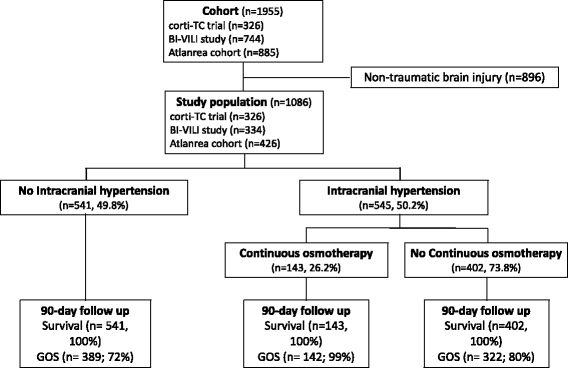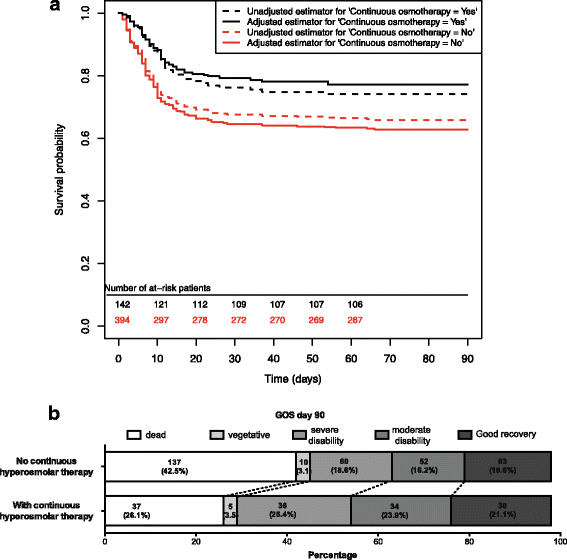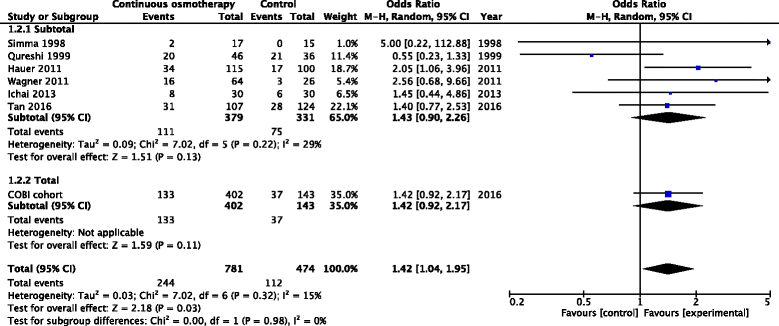Association between continuous hyperosmolar therapy and survival in patients with traumatic brain injury - a multicentre prospective cohort study and systematic review
- PMID: 29282104
- PMCID: PMC5745762
- DOI: 10.1186/s13054-017-1918-4
Association between continuous hyperosmolar therapy and survival in patients with traumatic brain injury - a multicentre prospective cohort study and systematic review
Abstract
Background: Intracranial hypertension (ICH) is a major cause of death after traumatic brain injury (TBI). Continuous hyperosmolar therapy (CHT) has been proposed for the treatment of ICH, but its effectiveness is controversial. We compared the mortality and outcomes in patients with TBI with ICH treated or not with CHT.
Methods: We included patients with TBI (Glasgow Coma Scale ≤ 12 and trauma-associated lesion on brain computed tomography (CT) scan) from the databases of the prospective multicentre trials Corti-TC, BI-VILI and ATLANREA. CHT consisted of an intravenous infusion of NaCl 20% for 24 hours or more. The primary outcome was the risk of survival at day 90, adjusted for predefined covariates and baseline differences, allowing us to reduce the bias resulting from confounding factors in observational studies. A systematic review was conducted including studies published from 1966 to December 2016.
Results: Among the 1086 included patients, 545 (51.7%) developed ICH (143 treated and 402 not treated with CHT). In patients with ICH, the relative risk of survival at day 90 with CHT was 1.43 (95% CI, 0.99-2.06, p = 0.05). The adjusted hazard ratio for survival was 1.74 (95% CI, 1.36-2.23, p < 0.001) in propensity-score-adjusted analysis. At day 90, favourable outcomes (Glasgow Outcome Scale 4-5) occurred in 45.2% of treated patients with ICH and in 35.8% of patients with ICH not treated with CHT (p = 0.06). A review of the literature including 1304 patients from eight studies suggests that CHT is associated with a reduction of in-ICU mortality (intervention, 112/474 deaths (23.6%) vs. control, 244/781 deaths (31.2%); OR 1.42 (95% CI, 1.04-1.95), p = 0.03, I 2 = 15%).
Conclusions: CHT for the treatment of posttraumatic ICH was associated with improved adjusted 90-day survival. This result was strengthened by a review of the literature.
Keywords: Brain oedema; Hyperosmolar therapy; Hypertonic; Intracranial hypertension; Saline solution; Sodium; Trauma; Traumatic brain injury.
Conflict of interest statement
Ethics approval and consent to participate
The study protocol of this sub-study of three prospective trials was approved by an institutional review board (Comité d'Éthique de la Recherche en Anesthésie-Réanimation, CERAR#2016-01-03). Informed consent was waived owing to the non-interventional design of this study and because relatives and patients provided informed consent for the collection of medical data in the original studies.
Consent for publication
Not applicable.
Competing interests
KA received funding for himself from LFB®, Fresenius® and Baxter®. Other authors declare that they have no competing interests.
Publisher's Note
Springer Nature remains neutral with regard to jurisdictional claims in published maps and institutional affiliations.
Figures




References
-
- Mokdad AH, Forouzanfar MH, Daoud F, Mokdad AA, El Bcheraoui C, Moradi-Lakeh M, et al. Global burden of diseases, injuries, and risk factors for young people's health during 1990-2013: a systematic analysis for the Global Burden of Disease Study 2013. Lancet. 2016;387:2383–401. doi: 10.1016/S0140-6736(16)00648-6. - DOI - PubMed
Publication types
MeSH terms
Substances
Grants and funding
LinkOut - more resources
Full Text Sources
Other Literature Sources
Medical

